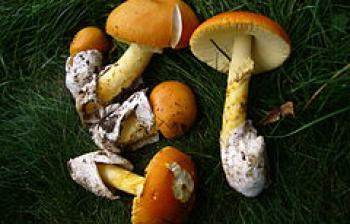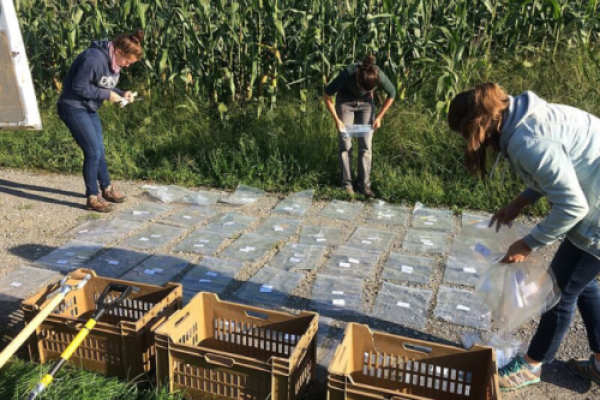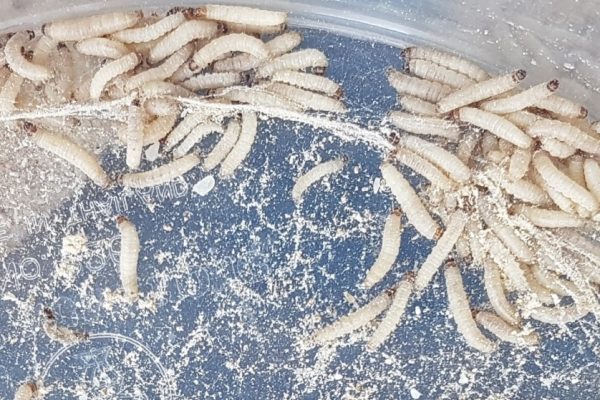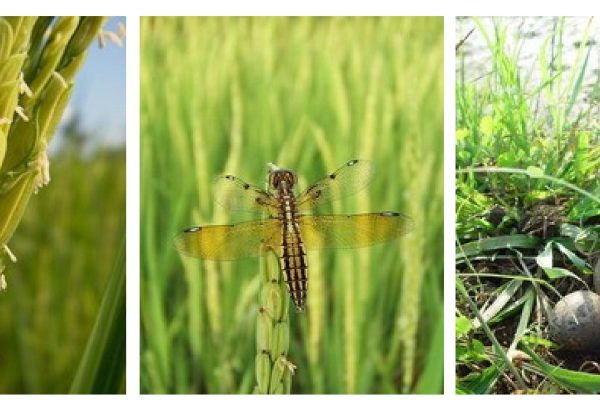
Dr. Uthai Unphim, of Ubon Rachathani University gave this lecture at the Golden Jubilee Museum of Agriculture (focuses on self-sufficiency agriculture) on how to grow mushrooms for 7 lifetimes or 7 centuries.
This professor is a mushroom expert. The technique is wonderfully simple and seems to make great sense for anyone who is doing some form of agroforestry, forest gardening, has a wooded area, or has access to woodlands, forests, etc nearby.
From early on in organic agriculture as discussed in the works of Sir Albert Howard great credit is given to the role of symbiotic mycorrhiza in the performance of plants and trees grown in organic conditions. These associations can give what might seem like a magic level of performance and benefit to crops. In the basics of nutrient accounting, one must consider the nutrient levels of the soil, what fertilizers one applies, and what a plant need to take up for its survival and optimal performance. So poor soil with no or limited fertilizer application should limit crop performance. However in living soils, we see that microorganisms play crucial roles. Nitrogen fixing bacteria found in legumes are best known. There are many other microorganisms that break down organic and even inorganic matter to convert it to forms that can be used by plants. Mycorrhiza are fungi that live in close association with plant roots. They cover these roots and effectively greatly extend the plant root’s surface area. These species help direct nutrients to their plant associate while receiving other nutrients for their own benefit. Mycorrhiza are also credited for providing protection to the roots from harmful disease fungi. Sir Albert Howard’s works show a very marked difference in performance between crops/ plants that have a beneficial mycorrhizal association and those which do not. Dr. Uthai did a study himself over several years which showed clear results of better growth for the trees that had mycorrhizal inoculation.
From this information, it is clear that if one could inoculate such mycorrhiza this would be good for one’s crops. Dr. Unphim explains that most of the wild harvested mushrooms here in Thailand are either mycorrhizal association species or have association with termite colonies. (Most cultivated mushrooms are saprophytic. They decompose dead organic matter such as wood, straw, manure, etc.)
This transformation may come naturally as one continues to improve the soil fertility of our land and with use of different forms of compost and microbial fermentations.
However from Dr. Unphim researched over several years, he found it is quite easy to introduce these species either into existing planted trees or to introduce the fungus at the seedling stage. This introduction means benefit for the plant and a continual source of edible mushrooms to harvest that should come every rainy season once established as long as the associated plant is alive.
The peak forest species of much of Thailand are from the genus, Dipterocarpus. (This genus has 2 winged seeds that are fun to play with as you can throw them in the air and they will spin and fly about) These trees live long and reach to the peak of the canopy. According to Dr. Unphim’s study, these species, and Dipterocarpus alatus (Yang Na) in particular, can host most all of the interesting edible mycorrhizal mushrooms while the Yang Na has an average lifespan of 700 years. Also according to Dr. Unphim, these huge trees can host a number of different mycorrhizal species at the same time. So you might harvest 5 varieties of mushroom from one tree (although he says they normally do not fruit together from the same tree). Thus if we plant Yang Na seedlings that are inoculated with edible mycorrhizal fungi, we and our ancestors may be able to harvest these mushrooms for 700 years. Talk about leaving heirlooms for your offspring.
 Dipterocarpus alatus (Courtesy Wikipedia)
Dipterocarpus alatus (Courtesy Wikipedia)
Dr. Unphim explains that one can propagate mushrooms 4 ways: 1 from soil where they grow, 2. from spores, 3. from mature mushrooms, and 4. from mycelium cultures. The easiest method for this task is the technique he has developed using mature mushrooms.
All you do is:
- Find mature mushrooms of varieties you want to propagate (mycorrhizal varieties). You could buy some from your market or roadside seller, or perhaps get a few from a mushroom hunter if you are not one yourself.
- Blend these mushrooms in a normal kitchen blender with water. Water should be chlorine free. Use rain water, well water, river water, or if tap water, let sit for a day to dechlorinate before use. Blend well.
- Strain the liquid.
- Dilute the liquid. (final desired ratios is 1 part mushrooms to 100-200 parts water. So 100 gm mushrooms can be mixed and diluted with 10-20 liters of water)
- Apply the liquid
- Apply to planted trees of species that can host this mushroom
Dig a shallow hole where new roots should be growing of this tree. Normally at same distance from trunk as leaf canopy.
Pour about 1 cup (100 ml) of the mushroom liquid in the hole
Add a handful of manure or compost. (this will attract the roots which will come to absorb nutrients and also take in the symbiotic fungus)
Cover will soil
Keep moist for 2-3 weeks. (can mulch or water as needed)
For a 2 year old tree it is recommended to use 3 holes spaced around evenly to get the fungus started in different places.
If this have been followed, fungus should be established. First fruiting (mushrooms) may be from 6 to 36 months later depending upon conditions. First fruiting may be small but production will normally increase every year.
- Apply to seedlings.
Water seedlings of host tree species with the mushroom liquid once or twice. If bags or pots of soil are hard and dry, they should be watered a first time normally, and then water with mushroom liquid the next day so it will be absorbed well. Then don’t water right away until moisture level is down.
Wait at least 1 week before planting such seedlings to let the fungus establish well.
Plant inoculated seedlings that are now really 2 species in one.
While this methodology has been developed here in Thailand using tropical host species, from information on wikipedia, one can see that a number of tasty species growing here such as porcini, and Green-cracking russula have mycorrhizal association with common species in America and Europe, like oaks, and poplars. There should also be other interesting species that grow in cooler latitudes that are mycorrhizal and can be propagated by the same methods.
While the most obvious point of caution is the need to get to know the varieties of mushrooms you want to collect and help propagate and be able to differentiate from non-edible similar species, Dr. Unphim mentioned about herbicide. Herbicide will not normally kill the fungus but the mycelium can absorb the fungus and put it into its fruiting bodies. So here it is known not to harvest or eat mushrooms from woods (such as rubber plantations) where herbicides are used. Here is another good reason to avoid using herbicide and follow organic production methods.
If you believe doing good can benefit you even after you have passed away, consider planting trees with tasty mushroom
Amanita caesarea (Courtesy Wikipedia)
inoculations. You may be helping to feed people for 700 years into the future.
Below are some common mycorrhizal fungus species consumed in Thailand that grow well in association with trees. Looking at information on the net to find the scientific names, I have noted that a few species commonly eaten here are considered inedible. I know I have eaten these (russula lepida, and russula densfolia) myself. It appears from the info that these species must be cooked to be edible (like some yam varieties) for if not they are mildly toxic. In any case it is rare to eat raw mushrooms in Thai cuisine. Of course one needs to know the species you choose to work with.
Porcini (boletus edulis) Phaeogyroporus porentosus
Grisette (amanita vaginata)
Green-cracking russula (Russula virescens)
Tricholoma crassum
Amanita caesarea
Below is one of the popular termite colony associated species eaten here. Such species can be spread to other termite mounds and habitats.
Termitomyces robustus
2 species below are popular to eat cooked in Thailand but considered inedible in some other countries according online info (wikipedia). They clearly have some toxicity if eaten raw.
Russula lepida
Russula densfolia
By Michael B. Commons, Earth Net Foundation, Thailand
References
*Lecture given at The Golden Jubilee Museum of Agriculture, located in Navanakorn (North of Bangkok). www.wisdomking.go.th
* Kaset Thammachart (Natural Farming) Magazine Issue 10, 2013- Has an article interviewing Dr. Uthai Unphim describing this in more detail (in Thai Language). This issue has a focus on mushrooms.



